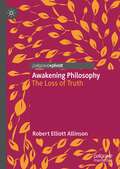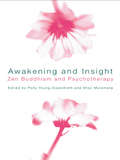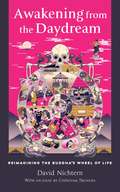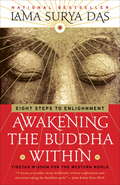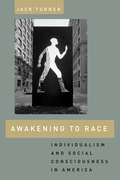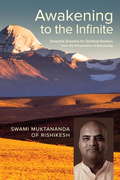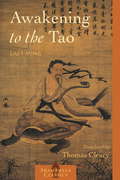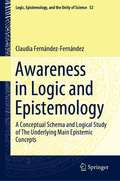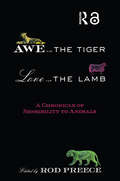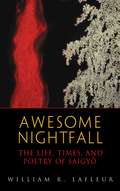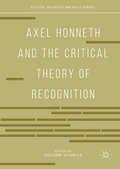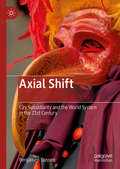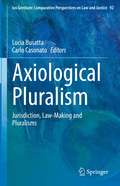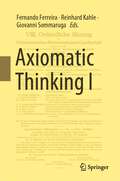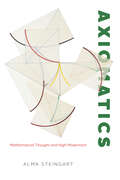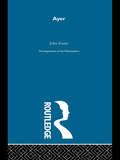- Table View
- List View
Awakening Philosophy: The Loss of Truth
by Robert Elliott AllinsonIn this original book, Robert Elliott Allinson asserts that philosophers have been lulled into a dogmatic sleep by Immanuel Kant, the slayer of metaphysics, who has convinced them (and the rest of humanity) that we can never know Reality. Allinson awakens global philosophers from their sceptical slumbers by diagnosing the reason why they have abdicated their traditional calling as leaders of inquiry into truth and wisdom.
Awakening Somatic Intelligence: Understanding, Learning & Practicing the Alexander Technique, Feldenkrais Method & Hatha Yoga
by Graeme LynnFocussing on distinct body practice from a range of different methods, Graeme Lynn demonstrates how to use the physical body to encourage general health and wellbeing. Starting with the fundamental concepts of movement to more advanced practice, this book will serve as a comprehensive guide to developing the physical body to transform the quality of movement, and bring greater pleasure and effectiveness into every action. Specific lessons include The Alexander Technique, The Feldenkrais Method, and Hatha Yoga. Describing the core benefits of these methods, why they complement each other and how to use them, this is essential reading for students and practitioners of somatic methods as well as anyone interested in learning new ways to optimise health and wellbeing.
Awakening Warrior: Revolution in the Ethics of Warfare (SUNY series, Ethics and the Military Profession)
by Timothy L. Challans2007 CHOICE Outstanding Academic TitleAwakening Warrior argues for a revolution in the ethics of warfare for the American War Machine—those political and military institutions that engage the world with physical force. Timothy L. Challans focuses on the systemic, institutional level of morality rather than bemoaning the moral shortcomings of individuals. He asks: What are the limits of individual moral agency? What kind of responsibility do individuals have when considering institutional moral error? How is it that neutral or benign moral actions performed by individuals can have such catastrophic morally negative effects from a systemic perspective? Drawing upon and extending the ethical theories of Kant, Dewey, and Rawls, Challans makes the case for an original set of moral principles to guide ethical action on the battlefield."…[Challans's] call for reformation combined with a demand for a new set of moral principles to govern the ethical behavior on the battlefield is certain to garner the attention and ire of many readers and military leaders." — Parameters"This is an important book that needs to be read and taken seriously. If it is, it could be as revolutionary as its subtitle suggests." — CHOICE
Awakening Your Ikigai: How The Japanese Wake Up To Joy And Purpose Every Day
by Ken Mogi“Awakening Your Ikigai is really quite a delightful look at sometimes mystifying Japanese traditions.”—The New York Times Book Review Introducing IKIGAI: find your passions and live with joy Ikigai is a Japanese phenomenon commonly understood as “your reason to get up in the morning.” Ikigai can be small moments: the morning air, a cup of coffee, a compliment. It can also be deep convictions: a fulfilling job, lasting friendships, balanced health. Whether big or small, your ikigai is the path to success and happiness in your own life. Author Ken Mogi introduces five pillars of ikigai to help you make the most of each day and become your most authentic self: 1. starting small › focus on the details 2. releasing yourself › accept who you are 3. harmony and sustainability › rely on others 4. the joy of little things › appreciate sensory pleasure 5. being in the here and now › find your flow. Weaving together insights from Japanese history, philosophy, and modern culture, plus stories from renowned sushi chef Jiro Ono, anime filmmaker Hayao Miyazaki, and others, Mogi skillfully shows the way to awaken your ikigai.
Awakening and Insight: Zen Buddhism and Psychotherapy
by Polly Young-Eisendrath Shoji MuramotoBuddhism first came to the West many centuries ago through the Greeks, who also influenced some of the culture and practices of Indian Buddhism. As Buddhism has spread beyond India, it has always been affected by the indigenous traditions of its new homes. When Buddhism appeared in America and Europe in the 1950s and 1960s, it encountered contemporary psychology and psychotherapy, rather than religious traditions. Since the 1990s, many efforts have been made by Westerners to analyze and integrate the similarities and differences between Buddhism and it therapeutic ancestors, particularly Jungian psychology. Taking Japanese Zen-Buddhism as its starting point, this volume is a collection of critiques, commentaries, and histories about a particular meeting of Buddhism and psychology. It is based on the Zen Buddhism and Psychotherapy conference that took place in Kyoto, Japan, in 1999, expanded by additional papers, and includes: new perspectives on Buddhism and psychology, East and West cautions and insights about potential confusions traditional ideas in a new light. It also features a new translation of the conversation between Schin'ichi Hisamatsu and Carl Jung which took place in 1958. Awakening and Insight expresses a meeting of minds, Japanese and Western, in a way that opens new questions about and sheds new light on our subjective lives. It will be of great interest to students, scholars and practitioners of psychotherapy, psychoanalysis, and analytical psychology, as well as anyone involved in Zen Buddhism.
Awakening from the Daydream: Reimagining the Buddha's Wheel of Life
by David NichternHell realms, gods, and hungry ghosts--these are just a few of the images on the Buddhist wheel of life. In Awakening from the Daydream, discover how these ancient symbols are still relevant to our modern life.In Awakening from the Daydream, meditation teacher David Nichtern reimagines the ancient Buddhist allegory of the Wheel of Life. Famously painted at the entryway to Buddhist monasteries, the Wheel of Life encapsulates the entirety of the human situation. In the image of the Wheel we find a teaching about how to make sense of life and how to find peace within an uncertain world. Nichtern writes with clarity and humor, speaking to our contemporary society and its concerns and providing simple practical steps for building a mindful, compassionate, and liberating approach to living.
Awakening the Buddha Within: Eight Steps to Enlightenment
by Lama Surya DasLama Surya Das, the most highly trained American lama in the Tibetan tradition, presents the first comprehensive book of Western Buddhism for the modern-day spiritual seeker. Buddhism offers a profound yet practical path to enlightenment. In this loving and generous book, the American-born and Tibetan-trained Lama Surya Das offers at once a definitive and nonsectarian guide to the wisdom found in ancient Tibetan teachings and a tried and true path of spiritual transformation. The radical and compelling message of Buddhism tells us that each of us has the wisdom, awareness, love, and power of the Buddha within; yet most of us are too often like sleeping Buddhas. Surya Das shows how we can awaken to who we really are and thus walk the liberating, peaceful path of mindful and compassionate living. With lively language, meditations, and spiritual practices, this unique book provides a bridge between East and West, past, present, and future. Awakening the Buddha Within offers a complete yet accessible understanding of the unique Buddhist teachings embodied in the traditional Noble Eight-Fold Path and its Three Enlightenment Trainings, common to all schools of Buddhism: Wisdom Training: Developing clear vision, insight, and inner understanding--seeing reality and ourselves as we really are. Ethics Training: Cultivating virtue, self-discipline, integrity, and compassion in what we say and do. Meditation Training: Practicing mindfulness, concentration, and awareness of the present moment. This fresh and original work illuminates such key principles as karma (what we do does matter), rebirth (every moment is an opportunity to start afresh), letting go (simplifying our lives by clarifying our hearts and minds), as well as conscious living and dying, and Dzogchen, the ultimate, mystical teaching of Tibet. In this wonderful marriage of the timeless and the timely, Surya Das has written an invaluable, authoritative text for the novice and the experienced student of Buddhism alike. Awakening the Buddha Withinreveals how sacred wisdom, contemplative practice, and altruism can be integrated into our outer and inner lives--in our relationships, in the workplace, and at home. Here is a guidebook to enlightenment--a sourcebook of the sacred for anyone who wants to lead a more serene and beautiful life.
Awakening to Race: Individualism and Social Consciousness in America
by Jack TurnerThe election of America's first black president has led many to believe that race is no longer a real obstacle to success and that remaining racial inequality stems largely from the failure of minority groups to take personal responsibility for seeking out opportunities. Often this argument is made in the name of the long tradition of self-reliance and American individualism. In Awakening to Race, Jack Turner upends this view, arguing that it expresses not a deep commitment to the values of individualism, but a narrow understanding of them. Drawing on the works of Ralph Waldo Emerson, Henry David Thoreau, Frederick Douglass, Ralph Ellison, and James Baldwin, Turner offers an original reconstruction of democratic individualism in American thought. All these thinkers, he shows, held that personal responsibility entails a refusal to be complicit in injustice and a duty to combat the conditions and structures that support it. At a time when individualism is invoked as a reason for inaction, Turner makes the individualist tradition the basis of a bold and impassioned case for race consciousness-consciousness of the ways that race continues to constrain opportunity in America. Turner's "new individualism" becomes the grounds for concerted public action against racial injustice.
Awakening to the Infinite
by Swami Muktananda of RishikeshRaised as a Catholic and educated in the West, then trained as a monk in India since the 1980s, Canadian author Swami Muktananda of Rishikesh is uniquely positioned to bring the Eastern tradition of Vedanta to Western spiritual seekers. In Awakening to the Infinite, he answers the eternal question posed by philosophical seekers, "Who am I?" with straightforward simplicity. Based on the ancient teachings of advaita or nonduality--the understanding that, at a fundamental level, there is no division between ourselves and others--the answers in the book are drawn from the many conversations Swami has had throughout the years with individuals from different backgrounds, cultures, and walks of life. Covering a range of subjects from the spiritual path to everyday problems at work and in relationships, sexuality, parenting, physical illness, and social injustice, Muktananda communicates directly and compassionately, from the standpoint of someone who is anchored in the infinite but fully in touch with the world.From the Trade Paperback edition.
Awakening to the Tao
by Thomas Cleary Lui I-MingThe Tao is the ancient Chinese "Way" that has inspired numerous books, from The Tao of Physics to The Tao of Sex . This book might be called "The Tao of Tao." In 142 brief meditative essays, the author uses simple language and natural imagery to express the essence of the wisdom that holds the key to success in every human endeavor. Liu I-ming (b. 1737) was a Taoist adept and a scholar of Buddhism and Confucianism. He is the author of commentaries on several Taoist classics that have been published in English, including The Taoist I Ching , also translated by Thomas Cleary.
Awakening: An Introduction to the History of Eastern Thought
by Patrick S. BresnanAwakening: An Introduction to the History of Eastern Thought provides the reader with a thorough and valuable overview of the historical development of the major Eastern religious and philosophical traditions, primarily in India, China, and Japan. The book is written in an engaging style that contains a variety of anecdotes, analogies, definitions, and supporting quotes from primary and secondary sources. Awakening helps the reader to recognize the interrelationships that exist among the various traditions, to appreciate the relevance of these traditions to the concerns of modern times, and to understand the major issues of interpretation regarding these traditions. The primary focus of Awakening is Hinduism and Buddhism, and they serve as the broad umbrellas that include a number of specific schools, each of which is treated individually. Other schools–such as Confucianism, Daoism, and Shinto–are included at the appropriate place. Awakening is for all students and interested readers, whether new to the study of Eastern thought or not. New to the Seventh Edition:- A new Introduction- A clearer definition and explanation of "Yoga" (throughout Part 1)- A rewrite of the Aryan Migration section in Chapter 1, bringing it in line with current research- An added sub-chapter to Chapter 6, dealing with Kundalini Yoga- Further clarification of the meaning of Anatman in Chapter 10- Emphasis on the contribution of Daoism to Chan Buddhism- Clearer presentation of the Life of Buddha (Legend vs. Reality)- Updated Study Questions- Two new videos added to the companion website Key Features:- An historical overview that attempts to show the development of Eastern philosophies, both within the individual traditions as well as within a broad but loosely unified system of thought- Abundantly uses stories in chapter overviews to engage student readers and to better explain Eastern thought- No background in Asian studies, philosophy, or religious studies is presumed, allowing any student to greatly benefit from reading this book- A functional, visually attractive web site www.patrickbresnan.com with author-produced videos on the content of the book, scores of pictures, and a comprehensive section on meditation
Awakening: An Introduction to the History of Eastern Thought (Mysearchlab Series 15% Off Ser.)
by Patrick S. BresnanAwakening: An Introduction to the History of Eastern Thought engages students with lively anecdotes, essential primary and secondary sources, an accessible writing style, and a clear historical approach. The text focuses primarily on India, China, and Japan, while showing the relationships that exist between Eastern and Western traditions. Patrick Bresnan consistently links the past to the present, so students may see that Eastern traditions, however ancient their origins, are living traditions and relevant to modern times. Updates to the Sixth Edition include a new introduction as well as new approaches to problem areas throughout the text, but with special emphasis in Chapter 5 (Ashtanga Yoga), Chapter 10 (Basic Teaching of Shakyamuni Buddha), Chapter 12(Mahayana Buddhism: Madhyamaka section) and Chapter 18 (Chan Buddhism: regarding the relationship of Chan Buddhism to Zen Buddhism). In addition, all references and source material have been brought up to date. The companion website includes two new videos and many new photos, produced by the author. New to this Sixth Edition: • A new introduction that provides a helpful overview of each of the nineteen chapters and important connections between them; • An improved explanation of the nature of Vedanta philosophy, and a more logical organization of the Key Elements of the Upanishads in Chapter 3; • An extensive rewrite of Chapter 5, which deals with the subject of Ashtanga Yoga as expressed in the Yoga Sutras of Patanjali; • A greatly improved presentation of Buddha’s “Four Noble Truths” in Chapter 10; • A total recasting of the teaching of Nagarjuna in the Madhyamaka section of Chapter 12; • A clearer and easier to understand presentation of the teaching of the Dao De Jing in Chapter 14; • A major revision of Chapter 18 so as to clearly distinguish Chinese Chan from Japanese Zen; • Greater emphasis throughout, where pertinent, on the role of meditation practice in all Eastern traditions; • Revised and updated Questions for Discussion at the end of each chapter; • New photos and two newly produced videos prepared by the author for the book’s companion website: http://patrickbresnan.com/.
Awareness in Logic and Epistemology: A Conceptual Schema and Logical Study of The Underlying Main Epistemic Concepts (Logic, Epistemology, and the Unity of Science #52)
by Claudia Fernández-FernándezThis book creates a conceptual schema that acts as a correlation between Epistemology and Epistemic Logic. It connects both fields and offers a proper theoretical foundation for the contemporary developments of Epistemic Logic regarding the dynamics of information. It builds a bridge between the view of Awareness Justification Internalism, and a dynamic approach to Awareness Logic. The book starts with an introduction to the main topics in Epistemic Logic and Epistemology and reviews the disconnection between the two fields. It analyses three core notions representing the basic structure of the conceptual schema: “Epistemic Awareness”, “Knowledge” and “Justification”. Next, it presents the Explicit Aware Knowledge (EAK) Schema, using a diagram of three ellipses to illustrate the schema, and a formal model based on a neighbourhood-model structure, that shows one concrete application of the EAK-Schema into a logical structure. The book ends by presenting conclusions and final remarks about the uses and applications of the EAK-Schema. It shows that the most important feature of the schema is that it serves both as a theoretical correlate to the dynamic extensions of Awareness Logic, providing it with a philosophical background, and as an abstract conceptual structure for a re-interpretation of Epistemology.
Awe for the Tiger, Love for the Lamb: A Chronicle of Sensibility to Animals
by Rod PreeceFirst Published in 2003. Routledge is an imprint of Taylor & Francis, an informa company.
Awesome Nightfall
by Saigyo William R LafleurAwesome Nightfall: The Life, Times, and Poetry of Saigyo captures the power of Saigyo's poetry and this previously overlooked poet's keen insight into the social and political world of medieval Japan. It also offers a fascinating look into the world of Japanese Buddhism prior to the wholesale influence of Zen.
Axel Honneth and the Critical Theory of Recognition (Political Philosophy and Public Purpose)
by Volker SchmitzThe critical theory of the Frankfurt School has undergone numerous and at times fundamental changes over the last ninety years. Since the late 1960s, it has been characterized primarily by Jürgen Habermas’s “communicative turn” and a focus on normative foundations. Today, that “second generation” exists side-by-side with a “third generation” represented most prominently by Axel Honneth’s turn toward recognition, ethical life, and the normative reconstruction of social institutions. This volume brings together critical voices on the state and direction of Frankfurt School theory today by examining Honneth’s theory in light of both current challenges and the intellectual and political ambitions that have shaped the tradition from its beginning. United in their strong commitment to critical scholarship, the authors collected here approach Honneth’s work from different backgrounds, employ a wide variety of methodologies, and write in different genres, ranging from the sober scholarly analysis to programmatic and political appeals. The collective aim of these reflections is not to reject Honneth’s theory but to build upon his work and incorporate his themes of recognition and social freedom into a new project of critical theory that can prove adequate to the political and social crises of our time.
Axial Shift: City Subsidiarity and the World System in the 21st Century
by Benjamen GussenThis book uses historical analysis, constitutional economics, and complexity theory to furnish an account of city subsidiarity as a legal, ethical, political, and economic principle. The book contemplates subsidiarity as a constitutional principle, where cities would benefit from much wider local autonomy. Constitutional economics suggests an optimal limit to jurisdictional footprints (territories). This entails preference for political orders where sovereignty is shared between different cities rather states where capital cities dominate. The introduction of city subsidiarity as a constitutional principle holds the key to economic prosperity in a globalizing world. Moreover, insights from complexity theory suggest subsidiarity is the only effective response to the ‘problem of scale.’ It is a fitness trait that prevents highly complex systems from collapsing. The nation-state is a highly complex system within which cities function as ‘attractors.’ The collapse of such systems would ensue if there were strong coupling between attractors. Such coupling obtains under legal monism. Only subsidiarity can make the eventuality of collapse improbable. The emergent and self-organizing properties of subsidiarity entail a shift in policy emphasis towards cities with a wide margin of autonomy.
Axiological Pluralism: Jurisdiction, Law-Making and Pluralisms (Ius Gentium: Comparative Perspectives on Law and Justice #92)
by Lucia Busatta Carlo CasonatoThis book analyses the features and functionality of the relationship between the law, individual or collective values and medical-scientific evidence when they have to be interpreted by judges, courts and para-jurisdictional bodies. The various degrees to which scientific data and moral values have been integrated into the legal discourse reveal the need for a systematic review of the options and solutions that judges have elaborated on. In turn, the book presents a systematic approach, based on a proposed pattern for classifying these various degrees, together with an in-depth analysis of the multi-layered role of jurisdictions and the means available to them for properly handling new legal demands arising in plural societies.The book outlines a model that makes it possible to focus on and address these issues in a sustainable manner, that is, to respond to individual requests and technological advances in the field of biolaw by consistently and effectively applying suitable legal instruments and jurisdictional interpretation.
Axiomatic Thinking I
by Giovanni Sommaruga Reinhard Kahle Fernando FerreiraIn this two-volume compilation of articles, leading researchers reevaluate the success of Hilbert's axiomatic method, which not only laid the foundations for our understanding of modern mathematics, but also found applications in physics, computer science and elsewhere.The title takes its name from David Hilbert's seminal talk Axiomatisches Denken, given at a meeting of the Swiss Mathematical Society in Zurich in 1917. This marked the beginning of Hilbert's return to his foundational studies, which ultimately resulted in the establishment of proof theory as a new branch in the emerging field of mathematical logic. Hilbert also used the opportunity to bring Paul Bernays back to Göttingen as his main collaborator in foundational studies in the years to come.The contributions are addressed to mathematical and philosophical logicians, but also to philosophers of science as well as physicists and computer scientists with an interest in foundations.Chapter 8 is available open access under a Creative Commons Attribution 4.0 International License via link.springer.com.
Axiomatic Thinking II
by Giovanni Sommaruga Reinhard Kahle Fernando FerreiraIn this two-volume compilation of articles, leading researchers reevaluate the success of Hilbert's axiomatic method, which not only laid the foundations for our understanding of modern mathematics, but also found applications in physics, computer science and elsewhere.The title takes its name from David Hilbert's seminal talk Axiomatisches Denken, given at a meeting of the Swiss Mathematical Society in Zurich in 1917. This marked the beginning of Hilbert's return to his foundational studies, which ultimately resulted in the establishment of proof theory as a new branch in the emerging field of mathematical logic. Hilbert also used the opportunity to bring Paul Bernays back to Göttingen as his main collaborator in foundational studies in the years to come.The contributions are addressed to mathematical and philosophical logicians, but also to philosophers of science as well as physicists and computer scientists with an interest in foundations.
Axiomatics: Mathematical Thought and High Modernism
by Alma SteingartThe first history of postwar mathematics, offering a new interpretation of the rise of abstraction and axiomatics in the twentieth century. Why did abstraction dominate American art, social science, and natural science in the mid-twentieth century? Why, despite opposition, did abstraction and theoretical knowledge flourish across a diverse set of intellectual pursuits during the Cold War? In recovering the centrality of abstraction across a range of modernist projects in the United States, Alma Steingart brings mathematics back into the conversation about midcentury American intellectual thought. The expansion of mathematics in the aftermath of World War II, she demonstrates, was characterized by two opposing tendencies: research in pure mathematics became increasingly abstract and rarified, while research in applied mathematics and mathematical applications grew in prominence as new fields like operations research and game theory brought mathematical knowledge to bear on more domains of knowledge. Both were predicated on the same abstractionist conception of mathematics and were rooted in the same approach: modern axiomatics. For American mathematicians, the humanities and the sciences did not compete with one another, but instead were two complementary sides of the same epistemological commitment. Steingart further reveals how this mathematical epistemology influenced the sciences and humanities, particularly the postwar social sciences. As mathematics changed, so did the meaning of mathematization. Axiomatics focuses on American mathematicians during a transformative time, following a series of controversies among mathematicians about the nature of mathematics as a field of study and as a body of knowledge. The ensuing debates offer a window onto the postwar development of mathematics band Cold War epistemology writ large. As Steingart’s history ably demonstrates, mathematics is the social activity in which styles of truth—here, abstraction—become synonymous with ways of knowing.
Axiomatics: Mathematical Thought and High Modernism
by Alma SteingartThe first history of postwar mathematics, offering a new interpretation of the rise of abstraction and axiomatics in the twentieth century. Why did abstraction dominate American art, social science, and natural science in the mid-twentieth century? Why, despite opposition, did abstraction and theoretical knowledge flourish across a diverse set of intellectual pursuits during the Cold War? In recovering the centrality of abstraction across a range of modernist projects in the United States, Alma Steingart brings mathematics back into the conversation about midcentury American intellectual thought. The expansion of mathematics in the aftermath of World War II, she demonstrates, was characterized by two opposing tendencies: research in pure mathematics became increasingly abstract and rarified, while research in applied mathematics and mathematical applications grew in prominence as new fields like operations research and game theory brought mathematical knowledge to bear on more domains of knowledge. Both were predicated on the same abstractionist conception of mathematics and were rooted in the same approach: modern axiomatics. For American mathematicians, the humanities and the sciences did not compete with one another, but instead were two complementary sides of the same epistemological commitment. Steingart further reveals how this mathematical epistemology influenced the sciences and humanities, particularly the postwar social sciences. As mathematics changed, so did the meaning of mathematization. Axiomatics focuses on American mathematicians during a transformative time, following a series of controversies among mathematicians about the nature of mathematics as a field of study and as a body of knowledge. The ensuing debates offer a window onto the postwar development of mathematics band Cold War epistemology writ large. As Steingart’s history ably demonstrates, mathematics is the social activity in which styles of truth—here, abstraction—become synonymous with ways of knowing.
Axiomatics: Mathematical Thought and High Modernism
by Alma SteingartThe first history of postwar mathematics, offering a new interpretation of the rise of abstraction and axiomatics in the twentieth century. Why did abstraction dominate American art, social science, and natural science in the mid-twentieth century? Why, despite opposition, did abstraction and theoretical knowledge flourish across a diverse set of intellectual pursuits during the Cold War? In recovering the centrality of abstraction across a range of modernist projects in the United States, Alma Steingart brings mathematics back into the conversation about midcentury American intellectual thought. The expansion of mathematics in the aftermath of World War II, she demonstrates, was characterized by two opposing tendencies: research in pure mathematics became increasingly abstract and rarified, while research in applied mathematics and mathematical applications grew in prominence as new fields like operations research and game theory brought mathematical knowledge to bear on more domains of knowledge. Both were predicated on the same abstractionist conception of mathematics and were rooted in the same approach: modern axiomatics. For American mathematicians, the humanities and the sciences did not compete with one another, but instead were two complementary sides of the same epistemological commitment. Steingart further reveals how this mathematical epistemology influenced the sciences and humanities, particularly the postwar social sciences. As mathematics changed, so did the meaning of mathematization. Axiomatics focuses on American mathematicians during a transformative time, following a series of controversies among mathematicians about the nature of mathematics as a field of study and as a body of knowledge. The ensuing debates offer a window onto the postwar development of mathematics band Cold War epistemology writ large. As Steingart’s history ably demonstrates, mathematics is the social activity in which styles of truth—here, abstraction—become synonymous with ways of knowing.
Ayer-Arg Philosophers (Arguments Of The Philosophers Ser.)
by John FosterFirst Published in 1999. Routledge is an imprint of Taylor & Francis, an informa company.
Ayn Rand Explained
by Marsha Familaro Enright Ronald E. MerrillFifty-five years after Atlas Shrugged, Ayn Rand is more in the news than ever. Ayn Rand Explained is an accurate and riveting account of Rand's life, work, and influence, with the emphasis on her ideas. The book covers Rand's career, from youth in Soviet Russia to Hollywood screenwriter and then to ideological guru; her novels and other fiction writings; her work in ethics, epistemology, and metaphysics; her influence on-and personal animosity toward-both conservatism and libertarianism. Rand's Objectivism encompasses the ethics of rational egoism ('The Virtue of Selfishness'); dedication to rational thinking and acting; rejection of faith in the supernatural, personal freedom from political interference, and a moral defense of limited government and laissez-faire. Objectivism was first promoted through the Nathaniel Branden Institute, headed by Rand's young protégé and designated heir. The Institute's phenomenally rapid growth was abruptly cut short when Rand expelled Branden and his followers in 1968. Today Objectivism is represented by different factions, notably the Ayn Rand Institute and the Atlas Society. This is a revised, updated edition of The Ideas of Ayn Rand (1991), including new information on Rand's rocketing influence, new stories about her personal relationships, and new analysis of her life and ideas.
